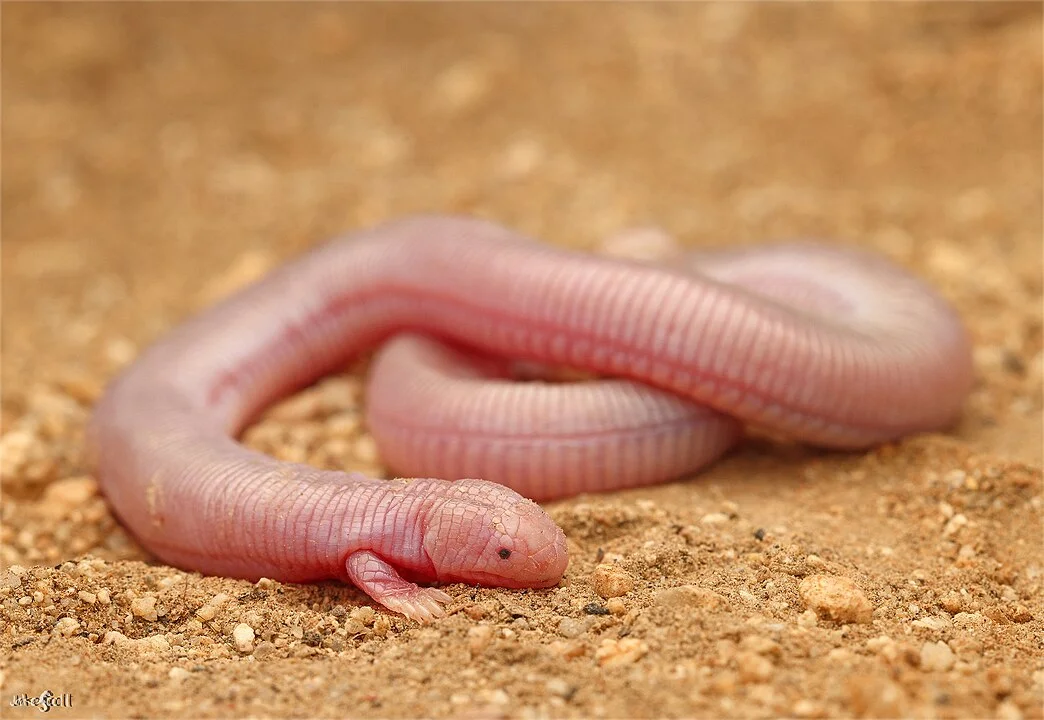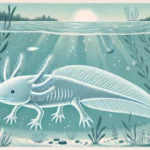The Mexican Mole Lizard (Bipes biporus), also known as the five-toed worm lizard, is one of the most unusual creatures in the animal kingdom. Found primarily in the Baja California region of Mexico, this reptile is neither fully lizard nor worm, but it possesses characteristics of both. Its unique appearance and behaviors have fascinated scientists and nature enthusiasts alike. Let’s explore seven strange facts about this elusive underground dweller.
1. It’s Not a Worm or a Lizard — But Both!
Despite its name, the Mexican Mole Lizard is neither a true mole nor a conventional lizard. Instead, it belongs to the family of amphisbaenians, a group of limbless or near-limbless reptiles that have evolved to live underground. Its worm-like appearance, with a long, segmented body and smooth, pinkish skin, gives it a resemblance to earthworms, but it has many reptilian traits.
The Mexican Mole Lizard has retained small, functional front limbs, unlike most amphisbaenians that have completely lost their limbs through evolution. These limbs help it dig and navigate underground, giving it a unique edge in the reptile world.
Key Characteristics:
- Amphisbaenian: Part of a group of burrowing reptiles, not worms.
- Front Limbs: Retains small, clawed front legs used for digging.
- Appearance: Worm-like body with a smooth, pink exterior.
2. It Has Two Front Legs, but No Back Legs
One of the most bizarre features of the Mexican Mole Lizard is its partial limb structure. While it has two small, well-developed front legs equipped with sharp claws, it has no back legs at all. This makes it a rare example of a creature with such an unusual combination of partial limb loss and retention.
The front legs are primarily used for digging, allowing the mole lizard to burrow through soft soil and sand. Its lack of hind limbs and its elongated, cylindrical body give it a worm-like appearance, helping it slither through tight spaces underground.
Limb Structure:
- Two Front Legs: Used for digging and moving through soil.
- No Back Legs: Streamlined body helps it burrow more efficiently.
- Digging Claws: The front limbs are equipped with claws for excavation.
3. A True Burrowing Specialist
The Mexican Mole Lizard spends most of its life underground, rarely coming to the surface unless forced to do so by heavy rains or other environmental factors. It is a specialized burrower, using its front limbs and strong head to push through loose soil in search of food and shelter.
Its smooth skin and flexible, segmented body allow it to move easily through tunnels without resistance. This underground lifestyle helps the mole lizard avoid predators and extreme weather conditions. It also spends much of its time hunting underground for prey, such as insects, larvae, and small invertebrates.
Burrowing Abilities:
- Lives Underground: Rarely surfaces unless disturbed.
- Efficient Burrower: Uses front limbs and head to dig through soil.
- Underground Predator: Hunts for insects and small invertebrates.
4. It Can Regenerate Its Tail
Like many lizards, the Mexican Mole Lizard has the remarkable ability to regenerate its tail if it is lost or damaged. This is a useful defense mechanism in the wild, allowing it to escape predators by shedding part of its tail, which can then grow back over time.
However, the regenerated tail is often shorter and less perfectly formed than the original. While this ability helps the mole lizard survive in its subterranean environment, the process of regeneration takes time and requires significant energy.
Tail Regeneration:
- Defense Mechanism: Can shed its tail to escape predators.
- Regrowth: Tail regenerates over time, though not always perfectly.
- Energy-Intensive: Regeneration requires energy and time.
5. It Has a Carnivorous Diet
The Mexican Mole Lizard is a carnivore, feeding on a diet of insects, small arthropods, and larvae. It uses its strong jaws and sharp teeth to catch and consume its prey, which it hunts primarily underground. This burrowing reptile is an opportunistic feeder, eating whatever small creatures it encounters while digging through the soil.
Its diet typically consists of ants, termites, and other small invertebrates, but it is also known to eat small lizards or worms if the opportunity arises. The mole lizard’s underground hunting strategy allows it to access food sources that many surface-dwelling predators cannot reach.
Diet:
- Carnivorous: Feeds on insects, small arthropods, and larvae.
- Underground Hunter: Hunts for food while burrowing.
- Opportunistic: Will eat whatever small creatures it finds.
6. It Has Poor Eyesight but Excellent Senses
Living underground in dark, narrow tunnels means that the Mexican Mole Lizard doesn’t rely much on sight. Its eyes are tiny and poorly developed, only capable of detecting light and shadow. Instead, it relies on other senses to navigate and hunt, including its keen sense of touch and vibration.
The mole lizard uses sensory receptors in its skin to detect vibrations and movements in the soil, helping it locate prey and avoid predators. Its reliance on these other senses makes it a highly effective underground hunter, despite its limited vision.
Senses:
- Poor Eyesight: Eyes are small and used primarily to detect light and darkness.
- Vibration Detection: Uses skin receptors to sense movement in the soil.
- Navigates by Touch: Relies on touch to move through its environment.
7. A Rare and Elusive Species
Despite its unique appearance and interesting behaviors, the Mexican Mole Lizard is relatively unknown outside of its native range. Its secretive, subterranean lifestyle makes it difficult to study, and it is rarely encountered by humans. However, it is not currently considered endangered, as its population remains stable in its preferred habitat.
The Mexican Mole Lizard is mostly found in the Baja California region of Mexico, where it inhabits desert scrublands and sandy areas with plenty of loose soil for burrowing. It is well-adapted to the dry, hot climate of the region and can go long periods without water, obtaining moisture from its prey.
Rarity:
- Elusive Creature: Rarely seen due to its underground lifestyle.
- Native Range: Found primarily in Baja California, Mexico.
- Stable Population: Not considered endangered, though rarely encountered.
Conclusion
The Mexican Mole Lizard is a truly unique species that defies the typical characteristics of most reptiles. With its worm-like body, partial limb structure, and subterranean lifestyle, it has adapted perfectly to life underground. Whether admired for its digging abilities or its fascinating anatomy, the Mexican Mole Lizard offers a glimpse into the diversity and adaptability of life on Earth.
FAQ
What is the Mexican Mole Lizard?
The Mexican Mole Lizard (Bipes biporus) is a burrowing reptile native to Baja California, Mexico, known for its worm-like appearance and two front limbs.
Does the Mexican Mole Lizard have legs?
Yes, it has two small, clawed front legs, but it lacks hind legs, making it unique among reptiles.
What does the Mexican Mole Lizard eat?
It is a carnivore that primarily feeds on insects, larvae, and small invertebrates, which it hunts underground.
Can the Mexican Mole Lizard regrow its tail?
Yes, like many lizards, the Mexican Mole Lizard can regenerate its tail if it is lost or damaged.
Where can the Mexican Mole Lizard be found?
It is found in the Baja California region of Mexico, where it inhabits sandy soils and desert scrublands.
Is the Mexican Mole Lizard endangered?
No, the Mexican Mole Lizard is not currently considered endangered, and its population is stable within its native range.


